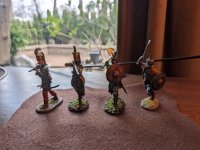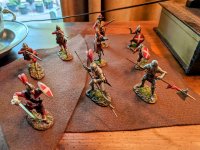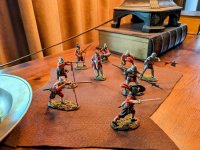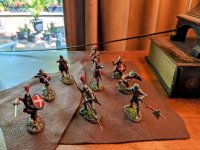- Joined
- Feb 2, 2011
- Messages
- 2,353
NEW RELEASES FOR MARCH 2024
THE CRUSADES
THE GREAT SIEGE OF MALTA 1565
In the mid-16th Century, a long running conflict between two of the most powerful world religions is building up to a climactic battle in the Mediterranean. Facing each other are the knights of the Order of St. John, a small but formidable and fanatical Christian military Order and the Muslim Janissaries, the fearsome crack troops of Suleyman the Magnificent.
The Great Siege of Malta occurred in 1565 when the Ottoman Empire attempted to conquer the Island of Malta, then held by the Knights Hospitaller.
The siege lasted nearly four months, from 18[SUP]th[/SUP] May to 11[SUP]th[/SUP] September 1565.
The forces of Suliman the Magnificent were impressive. The armies of the Sultan were hated and feared by the common folk of the west, and respected for their fighting prowess by the military.
The elite of the troops were, unusually for the time, infantry. The Janissaries were the backbone of the army.
A Janissary was a member of the elite infantry that formed the Ottoman Sultan’s household troops and were considered the first standing army in Europe. The corps was most likely established under the Sultan Orhan (1324-1362). Although the origins remain surrounded in mystery, they were also certainly among the first troops to adopt firearms as their principal weapon.
Janissaries began as elite corps made up through the system of child levy enslavement. They became famed for internal cohesion cemented by strict discipline and order. Unlike typical slaves, they were paid regular salaries. Forbidden to marry before the age of 40 or engage in trade, their complete loyalty to the Sultan was expected.
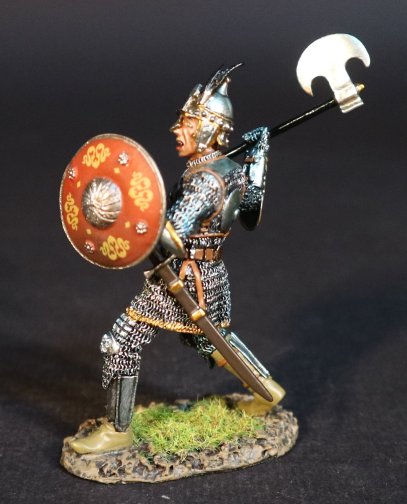
JAN-05
THE CRUSADES,
THE GREAT SIEGE OF MALTA 1565,
THE OTTOMAN EMPIRE,
JANISSARIES,
ZIHRIL NEFER, “ARMOURED ASSAULT SOLDIERS”.
(1 pc)
Zihril Nefer in Turkish means “armoured soldiers” and were a special category of Janissaries.
Zihril Nefer were made of volunteer Janissaries and received double pay. Their job was to lead the charge and attack the enemy at the most crucial or weakest point.
The best examples were at the Siege of Constantinople or the First Siege of Vienna where in both cases they charged at the crippled wall.
It is easy to conclude why these soldiers were armored and received double pay. Their casualties were very high. They were often called Serdengeçi meaning “the one who doesn’t care for their lives”.
It was also a good way to gain promotion which is one reason why there was never a shortage of volunteers.
The main body of the invasion force were the Spahis, drawn from Anatolia, Karamina, and Romania. Although originally cavalry, during a siege they would have little value. They were armed with bow, crossbow and matchlocks.
THE GREAT SIEGE OF MALTA 1565
The Great Siege of Malta occurred in 1565 when the Ottoman Empire attempted to conquer the Island of Malta, then held by the Knights Hospitaller.
The siege lasted nearly four months, from 18[SUP]th[/SUP] May to 11[SUP]th[/SUP] September 1565.
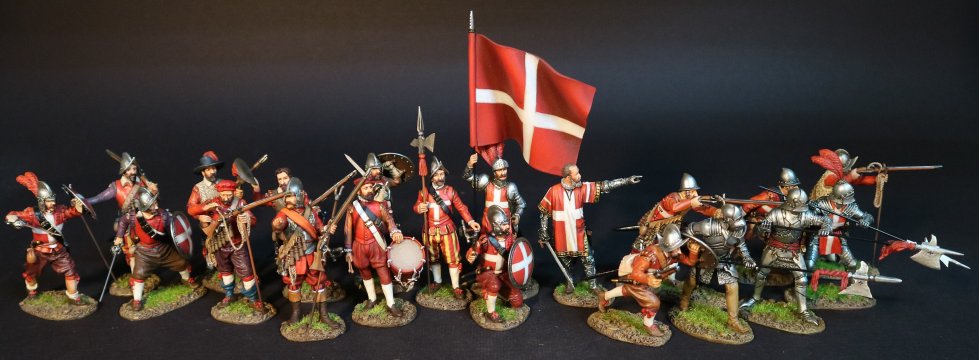
The Knights Hospitaller had been headquartered in Malta since 1530, after being driven out of Rhodes, also by the Ottomans, in 1522, following the Siege of Rhodes.
The Ottomans first attempted to take Malta in 1551 but failed. In 1565, Suleiman The Magnificent, the Ottoman Sultan, made a second attempt to take Malta.
The Knights, who numbered around 500 together with approximately 6,000 foot soldiers, withstood the siege and repelled the invaders. This victory became one of the most celebrated events of Sixteenth Century Europe, to the point that Voltaire said,
“Nothing is better known than the Siege of Malta”.
It undoubtedly contributed to the eventual erosion of the European perception of Ottoman invincibility, although the Mediterranean continued to be contested between Christian coalitions and the Muslim Turks for many years.
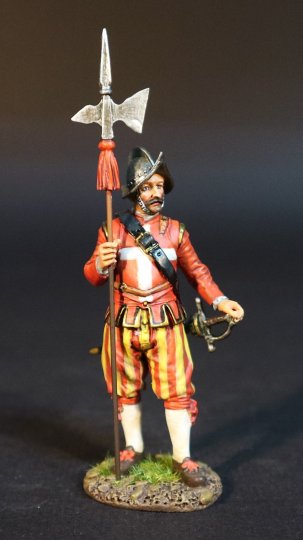
MALT-03
THE CRUSADES,
THE GREAT SIEGE OF MALTA 1565,
MALTESE MILITA.
(2 pcs)
THE CONQUEST OF AMERICA
THE JAMESTOWN SETTLEMENT
THE ANGLO-POWHATAN WARS
Spain, Portugal, and France moved quickly to establish a presence in the New World. The English did not attempt to establish colonies until many decades after their explorations of John Cabot, with early efforts proving to be failiures, most notably the Roanoke Colony which vanished around 1590.

The Jamestown settlement in the colony of Virginia was the first permanent English settlement in the Americas. It was located on the northwest bank of the James (powhatan) river, about 2 ½ miles southwest of the centre of modern Williamsburg.
It was established by the Virginia Company of London, as James Fort on May 4[SUP]th[/SUP] 1607.
The Anglo-Powhatan Wars were three conflicts fought between settlers of the Virginia Colony and Algonquin Indians of the Powhatan Confederacy in the early seventeenth Century.
The first war started in 1609 and ended in a peace settlement in 1614.
After several years of strained co-existence, Chief Opechancanough and his Powhatan Confederacy attempted to eliminate the English colony. This was the start of the second war which was to last from 1622 to 1626.
On the morning of March 22, 1622, the confederacy attacked outlying plantations and communities along the James River in what became known as the Indian Massacre of 1622.
More than 300 settlers were killed in the attack, which was about a third of the colony’s English speaking population.
Jamestown was spared only through a timely warning by a Virginia Indian employee.
Powhatan war practice was to wait and see what would happen after inflicting such a blow, in hopes that the settlement would simply abandon their homeland and move on elsewhere.
However, English military doctrine called for a strong response, and the colonial militia marched out nearly every summer for the next 10 years and made assaults on Powhatan settlements.
Opechancanough was to sue for peace in 1623.
The war lasted until Samuel Argall captured Wahunsenacawh’s daughter Matoaka, better known by her nickname Pocahontas, after which the chief accepted a treaty of peace.
The third war lasted from 1644 until 1646 and ended when Opechancanough was captured and killed. The war resulted in a defined boundary between the Indians and colonial lands that could only be crossed for official business with a special pass.
This situation lasted until 1677 and the Treaty of Middle Plantation which established Indian Reservations following Bacon’s Rebellion.
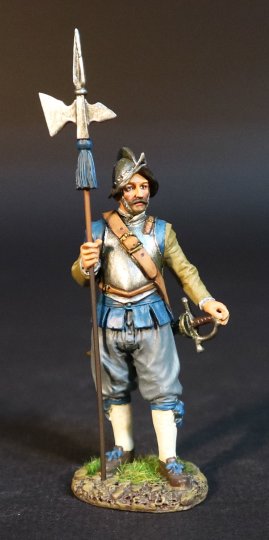
JT-03
THE CONQUEST OF AMERICA,
THE JAMESTOWN SETTLEMENT,
THE ANGLO-POWHATAN WARS
VIRGINIA MILITIA.
(2 pcs)
** PLEASE CONTACT YOUR LOCAL DEALER FOR FURTHER INFORMATION **
THE CRUSADES
THE GREAT SIEGE OF MALTA 1565
In the mid-16th Century, a long running conflict between two of the most powerful world religions is building up to a climactic battle in the Mediterranean. Facing each other are the knights of the Order of St. John, a small but formidable and fanatical Christian military Order and the Muslim Janissaries, the fearsome crack troops of Suleyman the Magnificent.
The Great Siege of Malta occurred in 1565 when the Ottoman Empire attempted to conquer the Island of Malta, then held by the Knights Hospitaller.
The siege lasted nearly four months, from 18[SUP]th[/SUP] May to 11[SUP]th[/SUP] September 1565.
The forces of Suliman the Magnificent were impressive. The armies of the Sultan were hated and feared by the common folk of the west, and respected for their fighting prowess by the military.
The elite of the troops were, unusually for the time, infantry. The Janissaries were the backbone of the army.
A Janissary was a member of the elite infantry that formed the Ottoman Sultan’s household troops and were considered the first standing army in Europe. The corps was most likely established under the Sultan Orhan (1324-1362). Although the origins remain surrounded in mystery, they were also certainly among the first troops to adopt firearms as their principal weapon.
Janissaries began as elite corps made up through the system of child levy enslavement. They became famed for internal cohesion cemented by strict discipline and order. Unlike typical slaves, they were paid regular salaries. Forbidden to marry before the age of 40 or engage in trade, their complete loyalty to the Sultan was expected.

JAN-05
THE CRUSADES,
THE GREAT SIEGE OF MALTA 1565,
THE OTTOMAN EMPIRE,
JANISSARIES,
ZIHRIL NEFER, “ARMOURED ASSAULT SOLDIERS”.
(1 pc)
Zihril Nefer in Turkish means “armoured soldiers” and were a special category of Janissaries.
Zihril Nefer were made of volunteer Janissaries and received double pay. Their job was to lead the charge and attack the enemy at the most crucial or weakest point.
The best examples were at the Siege of Constantinople or the First Siege of Vienna where in both cases they charged at the crippled wall.
It is easy to conclude why these soldiers were armored and received double pay. Their casualties were very high. They were often called Serdengeçi meaning “the one who doesn’t care for their lives”.
It was also a good way to gain promotion which is one reason why there was never a shortage of volunteers.
The main body of the invasion force were the Spahis, drawn from Anatolia, Karamina, and Romania. Although originally cavalry, during a siege they would have little value. They were armed with bow, crossbow and matchlocks.
THE GREAT SIEGE OF MALTA 1565
The Great Siege of Malta occurred in 1565 when the Ottoman Empire attempted to conquer the Island of Malta, then held by the Knights Hospitaller.
The siege lasted nearly four months, from 18[SUP]th[/SUP] May to 11[SUP]th[/SUP] September 1565.

The Knights Hospitaller had been headquartered in Malta since 1530, after being driven out of Rhodes, also by the Ottomans, in 1522, following the Siege of Rhodes.
The Ottomans first attempted to take Malta in 1551 but failed. In 1565, Suleiman The Magnificent, the Ottoman Sultan, made a second attempt to take Malta.
The Knights, who numbered around 500 together with approximately 6,000 foot soldiers, withstood the siege and repelled the invaders. This victory became one of the most celebrated events of Sixteenth Century Europe, to the point that Voltaire said,
“Nothing is better known than the Siege of Malta”.
It undoubtedly contributed to the eventual erosion of the European perception of Ottoman invincibility, although the Mediterranean continued to be contested between Christian coalitions and the Muslim Turks for many years.

MALT-03
THE CRUSADES,
THE GREAT SIEGE OF MALTA 1565,
MALTESE MILITA.
(2 pcs)
THE CONQUEST OF AMERICA
THE JAMESTOWN SETTLEMENT
THE ANGLO-POWHATAN WARS
Spain, Portugal, and France moved quickly to establish a presence in the New World. The English did not attempt to establish colonies until many decades after their explorations of John Cabot, with early efforts proving to be failiures, most notably the Roanoke Colony which vanished around 1590.

The Jamestown settlement in the colony of Virginia was the first permanent English settlement in the Americas. It was located on the northwest bank of the James (powhatan) river, about 2 ½ miles southwest of the centre of modern Williamsburg.
It was established by the Virginia Company of London, as James Fort on May 4[SUP]th[/SUP] 1607.
The Anglo-Powhatan Wars were three conflicts fought between settlers of the Virginia Colony and Algonquin Indians of the Powhatan Confederacy in the early seventeenth Century.
The first war started in 1609 and ended in a peace settlement in 1614.
After several years of strained co-existence, Chief Opechancanough and his Powhatan Confederacy attempted to eliminate the English colony. This was the start of the second war which was to last from 1622 to 1626.
On the morning of March 22, 1622, the confederacy attacked outlying plantations and communities along the James River in what became known as the Indian Massacre of 1622.
More than 300 settlers were killed in the attack, which was about a third of the colony’s English speaking population.
Jamestown was spared only through a timely warning by a Virginia Indian employee.
Powhatan war practice was to wait and see what would happen after inflicting such a blow, in hopes that the settlement would simply abandon their homeland and move on elsewhere.
However, English military doctrine called for a strong response, and the colonial militia marched out nearly every summer for the next 10 years and made assaults on Powhatan settlements.
Opechancanough was to sue for peace in 1623.
The war lasted until Samuel Argall captured Wahunsenacawh’s daughter Matoaka, better known by her nickname Pocahontas, after which the chief accepted a treaty of peace.
The third war lasted from 1644 until 1646 and ended when Opechancanough was captured and killed. The war resulted in a defined boundary between the Indians and colonial lands that could only be crossed for official business with a special pass.
This situation lasted until 1677 and the Treaty of Middle Plantation which established Indian Reservations following Bacon’s Rebellion.

JT-03
THE CONQUEST OF AMERICA,
THE JAMESTOWN SETTLEMENT,
THE ANGLO-POWHATAN WARS
VIRGINIA MILITIA.
(2 pcs)
** PLEASE CONTACT YOUR LOCAL DEALER FOR FURTHER INFORMATION **


